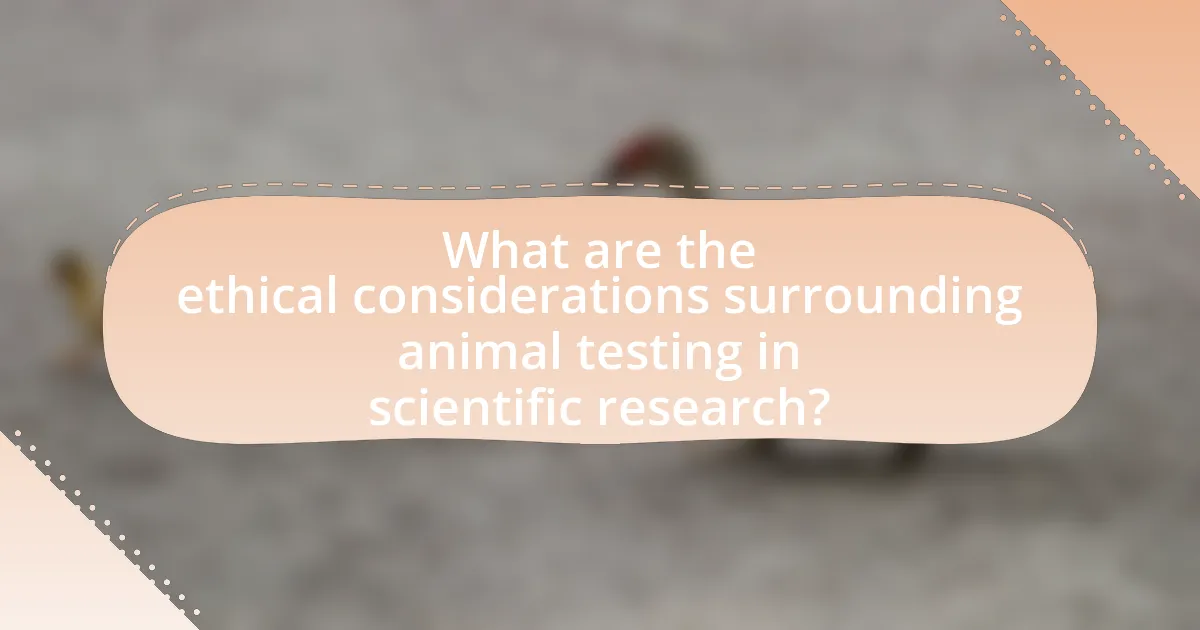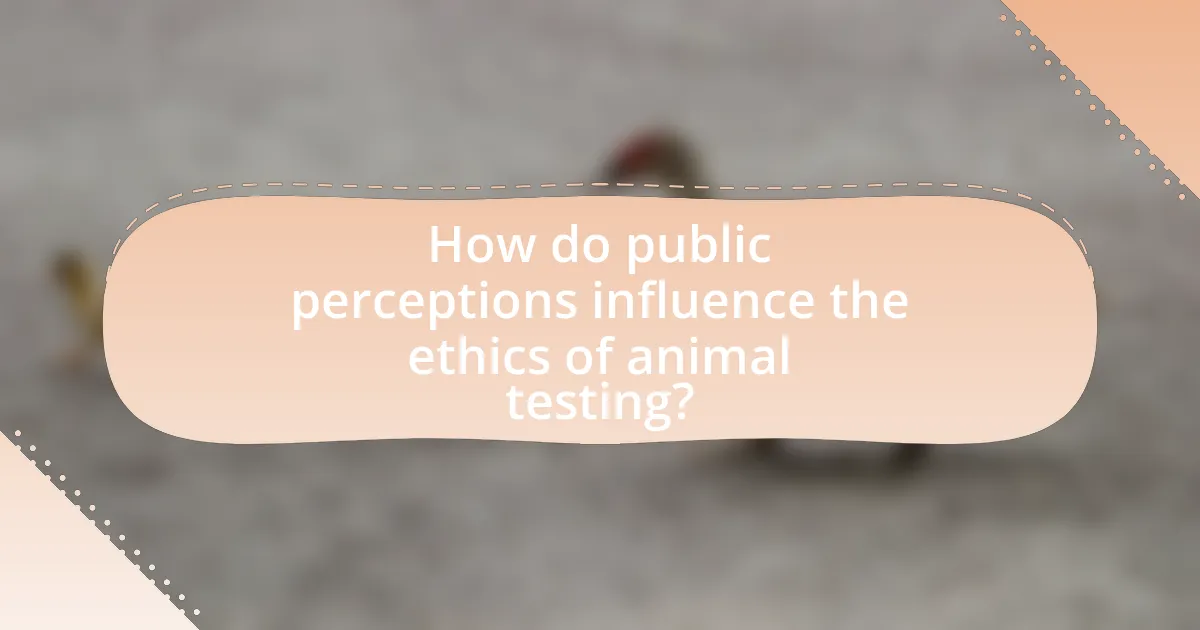The article examines the ethical considerations surrounding animal testing in scientific research, focusing on animal welfare, the necessity of research, and potential human benefits. It discusses the principle of the 3Rs—Replacement, Reduction, and Refinement—as a guiding framework for ethical practices. The article also outlines the reasons for using animal testing, the types of research that commonly utilize it, and the ethical frameworks that inform these practices, including utilitarianism and rights-based ethics. Additionally, it addresses public perceptions, regulatory frameworks, and the impact of advocacy groups on animal testing policies, while highlighting emerging alternatives to animal testing and the challenges researchers face in adopting these methods.

What are the ethical considerations surrounding animal testing in scientific research?
The ethical considerations surrounding animal testing in scientific research primarily involve the welfare of the animals, the necessity of the research, and the potential benefits to humans. Animal testing raises concerns about the suffering and pain inflicted on animals, as many procedures can cause distress or harm. The principle of the 3Rs—Replacement, Reduction, and Refinement—guides ethical practices, advocating for alternatives to animal testing, minimizing the number of animals used, and improving procedures to lessen suffering. Additionally, ethical frameworks emphasize the importance of justifying the use of animals by demonstrating that the potential human benefits, such as advancements in medicine, outweigh the ethical costs of using sentient beings in research.
Why is animal testing used in scientific research?
Animal testing is used in scientific research primarily to assess the safety and efficacy of new drugs and treatments before they are tested in humans. This practice allows researchers to observe biological effects, understand disease mechanisms, and evaluate potential side effects in a living organism. According to the National Institutes of Health, animal models are crucial for understanding human biology and disease, as they provide insights that cannot be obtained through in vitro studies alone. Furthermore, regulatory agencies often require animal testing data to ensure that new medical products are safe for human use, highlighting its role in the drug development process.
What types of research commonly utilize animal testing?
Animal testing is commonly utilized in biomedical research, toxicology studies, and behavioral research. Biomedical research often involves testing new drugs and therapies to assess their safety and efficacy before human trials. Toxicology studies evaluate the potential harmful effects of substances, such as chemicals and pharmaceuticals, on living organisms. Behavioral research examines the effects of various stimuli on animal behavior, providing insights into neurological and psychological conditions. These research types are essential for advancing medical knowledge and ensuring public safety.
How does animal testing contribute to scientific advancements?
Animal testing contributes to scientific advancements by providing essential insights into biological processes and the effects of treatments on living organisms. This practice has been pivotal in the development of vaccines, such as the polio vaccine, which was tested on monkeys and led to significant public health improvements. Additionally, animal models are crucial for understanding complex diseases, enabling researchers to study the progression of conditions like cancer and diabetes in a living system, which cannot be replicated through in vitro methods alone. Historical data shows that approximately 95% of the drugs that pass preclinical tests in animals fail in human trials, highlighting the necessity of animal testing in identifying effective therapies and ensuring safety before human application.
What ethical frameworks are applied to animal testing?
The ethical frameworks applied to animal testing include utilitarianism, rights-based ethics, and virtue ethics. Utilitarianism evaluates the moral justification of animal testing based on the balance of benefits versus harms, emphasizing the greatest good for the greatest number. Rights-based ethics argues that animals possess inherent rights that should not be violated, regardless of potential human benefits. Virtue ethics focuses on the character and intentions of the researchers, advocating for compassion and respect towards animals. These frameworks guide the ethical considerations and regulations surrounding animal testing in scientific research.
How do utilitarian principles justify animal testing?
Utilitarian principles justify animal testing by asserting that the benefits to human health and welfare outweigh the suffering inflicted on animals. This ethical framework evaluates actions based on their consequences, promoting actions that maximize overall happiness or utility. For instance, animal testing has led to significant medical advancements, including vaccines and treatments for diseases such as polio and diabetes, which have saved millions of human lives. The utilitarian perspective argues that if animal testing results in greater overall benefits for society, it can be deemed ethically permissible despite the ethical concerns regarding animal suffering.
What are the arguments against animal testing from a rights-based perspective?
Arguments against animal testing from a rights-based perspective assert that animals possess inherent rights that should not be violated for human benefit. This perspective emphasizes that animals are sentient beings capable of experiencing pain, suffering, and distress, which grants them moral consideration. The rights-based view argues that subjecting animals to testing undermines their autonomy and dignity, treating them as mere tools for experimentation rather than as beings with intrinsic value. Furthermore, it posits that the ethical implications of causing harm to animals cannot be justified by potential human gains, as this creates a moral hierarchy that prioritizes human interests over the rights of non-human animals. This perspective is supported by ethical frameworks such as utilitarianism and deontological ethics, which highlight the importance of respecting the rights of all sentient beings.
What regulations govern animal testing practices?
The regulations that govern animal testing practices primarily include the Animal Welfare Act (AWA) in the United States, which sets standards for the care and treatment of animals used in research. The AWA mandates that research facilities must provide adequate housing, nutrition, and veterinary care for animals, and it requires oversight by Institutional Animal Care and Use Committees (IACUCs) to ensure ethical treatment. Additionally, the Public Health Service Policy on Humane Care and Use of Laboratory Animals outlines requirements for research funded by the U.S. government, emphasizing the necessity of minimizing animal use and suffering. In the European Union, the Directive 2010/63/EU establishes comprehensive regulations for animal testing, focusing on the 3Rs principle: Replacement, Reduction, and Refinement, which aims to minimize the use of animals in research and improve their welfare. These regulations collectively ensure that animal testing is conducted ethically and responsibly, with a focus on humane treatment and scientific necessity.
Which organizations oversee animal welfare in research settings?
The organizations that oversee animal welfare in research settings include the Institutional Animal Care and Use Committees (IACUCs), the United States Department of Agriculture (USDA), and the National Institutes of Health (NIH). IACUCs are responsible for ensuring compliance with federal regulations regarding the care and use of animals in research, while the USDA enforces the Animal Welfare Act, which sets standards for animal care. The NIH provides guidelines and funding that promote humane animal research practices. These organizations collectively ensure that animal welfare is prioritized in scientific research.
What are the key laws and guidelines that researchers must follow?
Researchers must follow key laws and guidelines such as the Animal Welfare Act (AWA), the Public Health Service Policy on Humane Care and Use of Laboratory Animals, and the 3Rs principle (Replacement, Reduction, Refinement). The Animal Welfare Act establishes standards for the care and treatment of animals used in research, ensuring humane conditions. The Public Health Service Policy mandates that institutions receiving federal funding adhere to specific animal care standards, promoting ethical treatment. The 3Rs principle guides researchers to minimize animal use and suffering, emphasizing the importance of ethical considerations in scientific research. These laws and guidelines collectively ensure that animal testing is conducted responsibly and ethically.

How do public perceptions influence the ethics of animal testing?
Public perceptions significantly influence the ethics of animal testing by shaping societal norms and regulatory frameworks. When the public expresses strong opposition to animal testing, it can lead to stricter regulations and ethical guidelines, as seen in countries like the European Union, which has implemented bans on animal testing for cosmetics due to public outcry. Additionally, positive public perceptions of alternatives to animal testing, such as in vitro methods, can drive funding and research towards these ethical alternatives, further impacting the ethical landscape of animal testing practices.
What role does public opinion play in shaping animal testing policies?
Public opinion significantly influences animal testing policies by driving legislative changes and shaping ethical standards. When a substantial portion of the public expresses concern over animal welfare, policymakers often respond by enacting stricter regulations or promoting alternatives to animal testing. For instance, surveys indicate that approximately 70% of Americans oppose animal testing for cosmetics, leading to legislative efforts like the Humane Cosmetics Act, which aims to ban such practices. This demonstrates that public sentiment can directly impact the formulation and modification of animal testing policies, reflecting societal values regarding animal rights and ethical research practices.
How do media representations affect public attitudes towards animal testing?
Media representations significantly shape public attitudes towards animal testing by influencing perceptions of its ethical implications and necessity. For instance, portrayals in films, documentaries, and news articles often highlight the suffering of animals, which can evoke empathy and lead to increased opposition against animal testing. Research conducted by the University of Kent found that negative media coverage correlates with a rise in public disapproval of animal testing practices, indicating that emotional narratives can effectively sway public opinion. Additionally, campaigns by animal rights organizations utilize media to disseminate information that frames animal testing as cruel and unnecessary, further reinforcing negative attitudes.
What are the common misconceptions about animal testing?
Common misconceptions about animal testing include the belief that it is unnecessary, that it is always cruel, and that it does not provide relevant data for human health. Many people think animal testing is obsolete due to advancements in technology; however, it remains a critical component in biomedical research for understanding complex biological systems. Additionally, while some animal testing practices have been criticized for ethical concerns, regulations exist to ensure humane treatment, and many researchers prioritize animal welfare. Lastly, the idea that results from animal testing are not applicable to humans is misleading; studies have shown that animal models can effectively predict human responses, as evidenced by the FDA’s reliance on animal testing for drug approval processes.
How do advocacy groups impact animal testing practices?
Advocacy groups significantly influence animal testing practices by raising public awareness and promoting alternatives to animal research. These organizations, such as PETA and the Humane Society, engage in campaigns that highlight ethical concerns, leading to increased scrutiny of animal testing methods. For instance, the European Union’s ban on animal testing for cosmetics in 2013 was largely driven by advocacy efforts that emphasized humane treatment and the availability of alternative testing methods. Additionally, advocacy groups often lobby for legislative changes, resulting in stricter regulations and funding for non-animal research techniques. Their impact is evident in the growing adoption of in vitro and computer modeling methods, which reduce reliance on animal testing.
What strategies do animal rights organizations use to promote their views?
Animal rights organizations employ various strategies to promote their views, including public awareness campaigns, legislative advocacy, and grassroots mobilization. Public awareness campaigns often utilize social media, documentaries, and advertisements to highlight animal suffering and promote alternatives to animal testing. Legislative advocacy involves lobbying for laws that protect animal rights, such as the Animal Welfare Act, which sets standards for the treatment of animals in research. Grassroots mobilization encourages community involvement through protests, petitions, and educational events, fostering a collective voice for animal rights. These strategies are supported by research indicating that public engagement and policy change can significantly impact animal welfare standards.
How effective are campaigns against animal testing in changing practices?
Campaigns against animal testing are effective in changing practices, as evidenced by a significant reduction in animal use in research and the adoption of alternative methods. For instance, the European Union’s ban on animal testing for cosmetics in 2013 led to a 65% decrease in animal use for cosmetic testing by 2018. Additionally, organizations like PETA and the Humane Society International have successfully lobbied for legislative changes and increased public awareness, resulting in companies like L’Oréal and Unilever committing to cruelty-free practices. These campaigns have not only influenced regulatory frameworks but also shifted consumer preferences towards cruelty-free products, demonstrating their impact on industry practices.

What alternatives to animal testing are being developed?
Alternatives to animal testing being developed include in vitro testing, computer modeling, and organ-on-a-chip technologies. In vitro testing utilizes human cells and tissues to assess the safety and efficacy of substances, providing more relevant data than animal models. Computer modeling employs algorithms and simulations to predict biological responses, significantly reducing the need for live subjects. Organ-on-a-chip technologies mimic human organ systems on microchips, allowing researchers to study disease mechanisms and drug interactions in a controlled environment. These methods are supported by regulatory agencies, such as the European Union’s REACH regulation, which encourages the use of non-animal testing methods to enhance human relevance and reduce ethical concerns associated with animal experimentation.
What are the most promising alternatives to animal testing?
The most promising alternatives to animal testing include in vitro testing, computer modeling, and organ-on-a-chip technologies. In vitro testing utilizes human cells and tissues to assess biological responses, providing relevant data without the ethical concerns associated with animal use. Computer modeling employs algorithms and simulations to predict human responses based on existing data, significantly reducing the need for animal subjects. Organ-on-a-chip technologies replicate human organ functions on microchips, allowing researchers to study drug effects and disease mechanisms in a controlled environment. These methods are supported by advancements in biotechnology and have been shown to produce reliable results, making them viable substitutes for traditional animal testing.
How do in vitro methods compare to animal testing in terms of effectiveness?
In vitro methods are often considered more effective than animal testing for specific applications, particularly in drug development and toxicity testing. In vitro techniques allow for controlled environments that can mimic human biological responses more accurately, leading to better predictive outcomes for human reactions. For instance, a study published in the journal “Nature” by the National Institutes of Health found that in vitro assays can predict human drug responses with up to 90% accuracy, while animal models often show only 60-70% correlation with human outcomes. This evidence suggests that in vitro methods can provide more reliable data for human health assessments compared to traditional animal testing.
What role does technology play in reducing the need for animal testing?
Technology significantly reduces the need for animal testing by providing alternative methods such as in vitro testing, computer modeling, and organ-on-a-chip systems. These advancements allow researchers to simulate human biological responses without using live animals, thereby minimizing ethical concerns associated with animal testing. For instance, in vitro methods can assess toxicity and efficacy of substances using human cells, while computer models can predict drug interactions and effects based on existing data. According to a report by the National Institutes of Health, these technologies have the potential to replace up to 90% of animal testing in certain areas, demonstrating their effectiveness and reliability in scientific research.
How can researchers transition to alternative methods?
Researchers can transition to alternative methods by adopting in vitro techniques, computer modeling, and human-based studies. In vitro techniques, such as cell cultures, allow for the examination of biological processes without the use of animals, providing relevant data on human biology. Computer modeling, including simulations and predictive algorithms, can analyze complex biological interactions and predict outcomes, reducing the need for animal testing. Human-based studies, such as clinical trials and observational studies, offer direct insights into human responses, further minimizing reliance on animal models. These methods have been validated through various studies, demonstrating their effectiveness in providing reliable data while addressing ethical concerns associated with animal testing.
What challenges do researchers face when adopting alternative testing methods?
Researchers face significant challenges when adopting alternative testing methods, primarily due to regulatory hurdles and validation processes. Regulatory agencies often require extensive data to ensure that alternative methods are reliable and predictive of human responses, which can delay their acceptance. Additionally, the validation of these methods against established animal models is complex and time-consuming, as it necessitates comprehensive studies to demonstrate equivalency in results. For instance, the European Union’s REACH regulation mandates that new testing methods must undergo rigorous validation before they can replace animal testing, which can prolong the transition to alternative methods.
What best practices can researchers follow to minimize animal testing?
Researchers can minimize animal testing by employing alternative methods such as in vitro testing, computer modeling, and advanced imaging techniques. In vitro testing allows for the examination of biological processes using cell cultures, which can reduce the need for live animal subjects. Computer modeling simulates biological interactions and can predict outcomes without animal involvement, while advanced imaging techniques provide insights into biological processes in real-time without invasive procedures. According to a report by the National Institutes of Health, these alternatives not only reduce animal use but can also enhance the relevance and applicability of research findings.